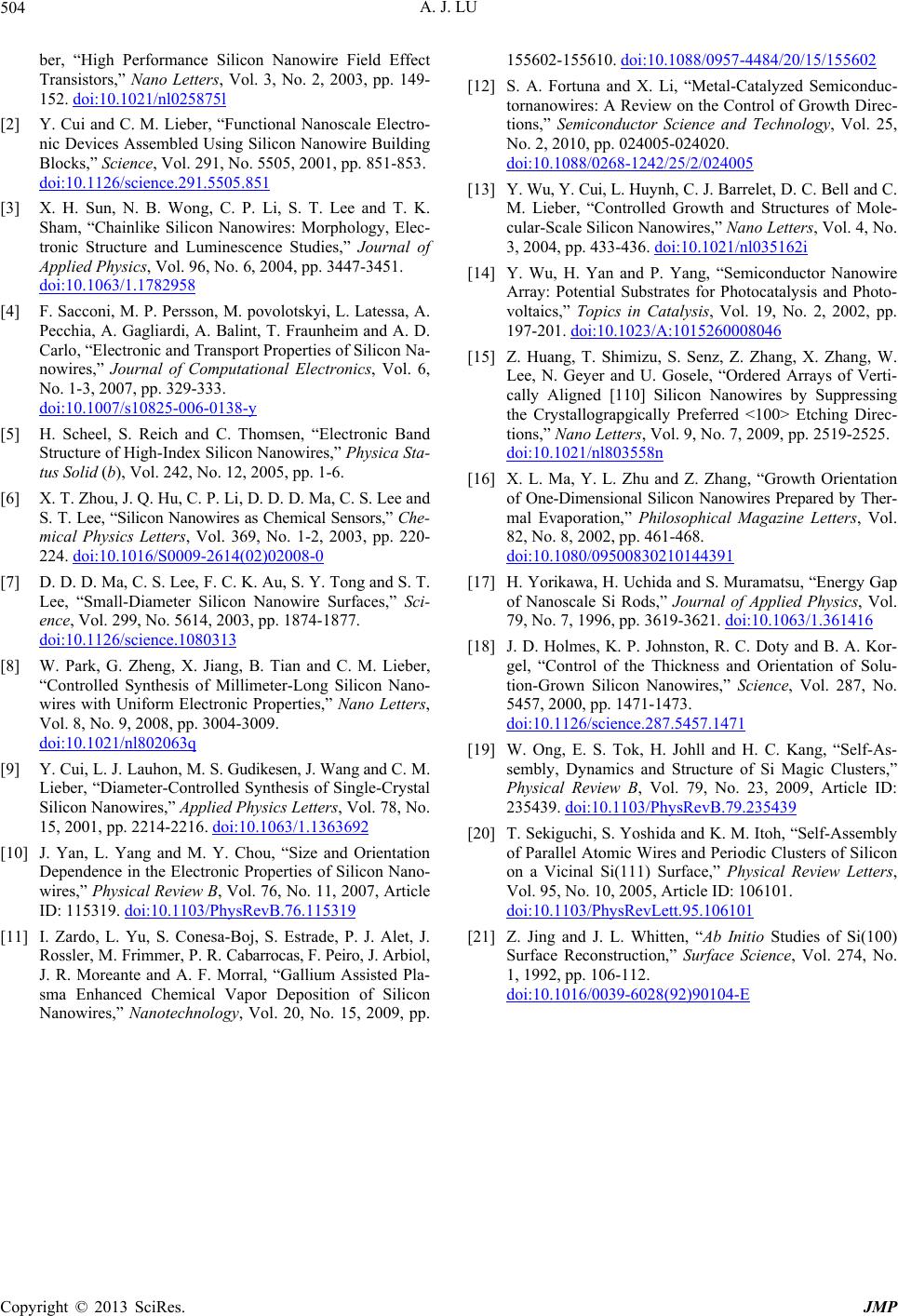
A. J. LU
Copyright © 2013 SciRes. JMP
504
ber, “High Performance Silicon Nanowire Field Effect
Transistors,” Nano Letters, Vol. 3, No. 2, 2003, pp. 149-
152. doi:10.1021/nl025875l
[2] Y. Cui and C. M. Lieber, “Functional Nanoscale Electro-
nic Devices Assembled Using Silicon Nanowire Building
Blocks,” Science, Vol. 291, No. 5505, 2001, pp. 851-853.
doi:10.1126/science.291.5505.851
[3] X. H. Sun, N. B. Wong, C. P. Li, S. T. Lee and T. K.
Sham, “Chainlike Silicon Nanowires: Morphology, Elec-
tronic Structure and Luminescence Studies,” Journal of
Applied Physics, Vol. 96, No. 6, 2004, pp. 3447-3451.
doi:10.1063/1.1782958
[4] F. Sacconi, M. P. Persson, M. povolotskyi, L. Latessa, A.
Pecchia, A. Gagliardi, A. Balint, T. Fraunheim and A. D.
Carlo, “Electronic and Transport Properties of Silicon Na-
nowires,” Journal of Computational Electronics, Vol. 6,
No. 1-3, 2007, pp. 329-333.
doi:10.1007/s10825-006-0138-y
[5] H. Scheel, S. Reich and C. Thomsen, “Electronic Band
Structure of High-Index Silicon Nanowires,” Physica Sta-
tus Solid (b), Vol. 242, No. 12, 2005, pp. 1-6.
[6] X. T. Zhou, J. Q. Hu, C. P. Li, D. D. D. Ma, C. S. Lee and
S. T. Lee, “Silicon Nanowires a s Chemical Sensors,” Che-
mical Physics Letters, Vol. 369, No. 1-2, 2003, pp. 220-
224. doi:10.1016/S0009-2614(02)02008-0
[7] D. D. D. Ma, C. S. Lee, F. C. K. Au, S. Y. Tong and S. T.
Lee, “Small-Diameter Silicon Nanowire Surfaces,” Sci-
ence, Vol. 299, No. 5614, 2003, pp. 1874-1877.
doi:10.1126/science.1080313
[8] W. Park, G. Zheng, X. Jiang, B. Tian and C. M. Lieber,
“Controlled Synthesis of Millimeter-Long Silicon Nano-
wires with Uniform Electronic Properties,” Nano Letters,
Vol. 8, No. 9, 2008, pp. 3004-3009.
doi:10.1021/nl802063q
[9] Y. Cui, L. J. Lauhon, M. S. Gudikesen, J. Wang and C. M.
Lieber, “Diameter-Controlled Synthesis of Single-Crystal
Silicon Nanowires,” Applied Physics Letters, Vol. 78, No.
15, 2001, pp. 2214-2216. doi:10.1063/1.1363692
[10] J. Yan, L. Yang and M. Y. Chou, “Size and Orientation
Dependence in the Electronic Properties of Silicon Nano-
wires,” Physical Review B, Vol. 76, No. 11, 2007, Article
ID: 115319. doi:10.1103/PhysRevB.76.115319
[11] I. Zardo, L. Yu, S. Conesa-Boj, S. Estrade, P. J. Alet, J.
Rossler, M. Frimmer, P. R. Cabarrocas, F. Peiro, J. Arbiol,
J. R. Moreante and A. F. Morral, “Gallium Assisted Pla-
sma Enhanced Chemical Vapor Deposition of Silicon
Nanowires,” Nanotechnology, Vol. 20, No. 15, 2009, pp.
155602-155610. doi:10.1088/0957-4484/20/15/155602
[12] S. A. Fortuna and X. Li, “Metal-Catalyzed Semiconduc-
tornanowires: A Review on the Control of Growth Direc-
tions,” Semiconductor Science and Technology, Vol. 25,
No. 2, 2010, pp. 024005-024020.
doi:10.1088/0268-1242/25/2/024005
[13] Y. Wu, Y. Cui, L. Huynh, C. J. Barrelet, D. C. Bell and C.
M. Lieber, “Controlled Growth and Structures of Mole-
cular-Scale Silicon Nanowires,” Nano Letters, Vol. 4, No.
3, 2004, pp. 433-436. doi:10.1021/nl035162i
[14] Y. Wu, H. Yan and P. Yang, “Semiconductor Nanowire
Array: Potential Substrates for Photocatalysis and Photo-
voltaics,” Topics in Catalysis, Vol. 19, No. 2, 2002, pp.
197-201. doi:10.1023/A:1015260008046
[15] Z. Huang, T. Shimizu, S. Senz, Z. Zhang, X. Zhang, W.
Lee, N. Geyer and U. Gosele, “Ordered Arrays of Verti-
cally Aligned [110] Silicon Nanowires by Suppressing
the Crystallograpgically Preferred <100> Etching Direc-
tions,” Nano Letters, Vol. 9, No. 7, 2009, pp. 2519-2525.
doi:10.1021/nl803558n
[16] X. L. Ma, Y. L. Zhu and Z. Zhang, “Growth Orientation
of One-Dimensional Silicon Nanowires Prepared by Ther-
mal Evaporation,” Philosophical Magazine Letters, Vol.
82, No. 8, 2002, pp. 461-468.
doi:10.1080/09500830210144391
[17] H. Yorikawa, H. Uchida and S. Muramatsu , “Energy Gap
of Nanoscale Si Rods,” Journal of Applied Physics, Vol.
79, No. 7, 1996, pp. 3619-3621. doi:10.1063/1.361416
[18] J. D. Holmes, K. P. Johnston, R. C. Doty and B. A. Kor-
gel, “Control of the Thickness and Orientation of Solu-
tion-Grown Silicon Nanowires,” Science, Vol. 287, No.
5457, 2000, pp. 1471-1473.
doi:10.1126/science.287.5457.1471
[19] W. Ong, E. S. Tok, H. Johll and H. C. Kang, “Self-As-
sembly, Dynamics and Structure of Si Magic Clusters,”
Physical Review B, Vol. 79, No. 23, 2009, Article ID:
235439. doi:10.1103/PhysRevB.79.235439
[20] T. Sekiguchi, S. Yoshida and K. M. Itoh, “Self-Assembly
of Parallel Atomic Wires and Periodic Clusters of Silicon
on a Vicinal Si(111) Surface,” Physical Review Letters,
Vol. 95, No. 10, 2005, Article ID: 106101.
doi:10.1103/PhysRevLett.95.106101
[21] Z. Jing and J. L. Whitten, “Ab Initio Studies of Si(100)
Surface Reconstruction,” Surface Science, Vol. 274, No.
1, 1992, pp. 106-112.
doi:10.1016/0039-6028(92)90104-E